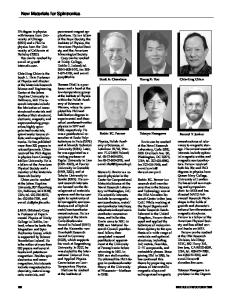Wide Bandgap Materials for Semiconductor Spintronics
- PDF / 623,929 Bytes
- 12 Pages / 612 x 792 pts (letter) Page_size
- 19 Downloads / 323 Views
Z9.6.1
Wide Bandgap Materials for Semiconductor Spintronics S.J.Pearton (1),C.R.Abernathy(1),G.T.Thaler(1) , R.Frazier (1), D.P.Norton (1) ,J.Kelly(2), R.Rairigh (2) A.F.Hebard(2), Y.D.Park(3) and J.M.Zavada(4) (1) Department of Materials Science and Engineering, University of Florida, Gainesville, FL 32611 USA (2) Department of Physics, University of Florida, Gainesville, FL 32611 USA (3) Center for Strongly Correlated Materials Research, Seoul,151-747,Korea (4) US Army Research Office, Research Triangle Park, NC 27709,USA ABSTRACT Existing semiconductor electronic and photonic devices utilize the charge on electrons and holes in order to perform their specific functionality such as signal processing or light emission. The relatively new field of semiconductor spintronics seeks, in addition, to exploit the spin of charge carriers in new generations of transistors, lasers and integrated magnetic sensors. The ability to control of spin injection, transport and detection leads to the potential for new classes of ultra-low power, high speed memory, logic and photonic devices. The utility of such devices depends on the availability of materials with practical (>300K) magnetic ordering temperatures. In this paper, we summarize recent progress in dilute magnetic semiconductors such as (Ga,Mn)N, (Ga,Mn)P and (Zn,Mn)O exhibiting room temperature ferromagnetism, the origins of the magnetism and its potential applications in novel devices such as spin-polarized light emitters and spin field effect transistors. INTRODUCTION The use of electron spin, in addition its more commonly used charge, holds great promise for a new class of semiconductor memory and signal processing devices with new functionality.(1-7) For a long period electron spin in metals has been exploited in information storage and in particular the giant magneto-resistance (GMR) effect, where the resistance of a thin-film ferromagnetic/nonmagnetic layer sandwich is strongly magnetic field dependent (8) is used in most computer hard drives. In recent years, attention has also focused on spin-dependent phenomena in semiconductors. A potential device embodiment is the spin field effect transistor (FET) in which the drain and source of a conventional FET are ferromagnetic(9). If the two ferromagnets are aligned, a spinpolarized current will behave like a normal FET current. If the ferromagnets are antialigned,the transistor will be shut off. This could be done dynamically, allowing for microprocessors that reconfigure their hardware in real time. A major hindrance for the practical implementation of the above concepts is that they require efficient spin-polarized carrier injection and transport. Conventional ferromagnetic metals are often incompatible with existing semiconductor technology. Moreover, the spin injection efficiency is often very low due to resistivity differences and to the formation of Schottky barriers(10,11). A key materials aspect to overcoming this problem is the use of dilute magnetic semiconductors (DMSs). These materials are alloys where a sto
Data Loading...


